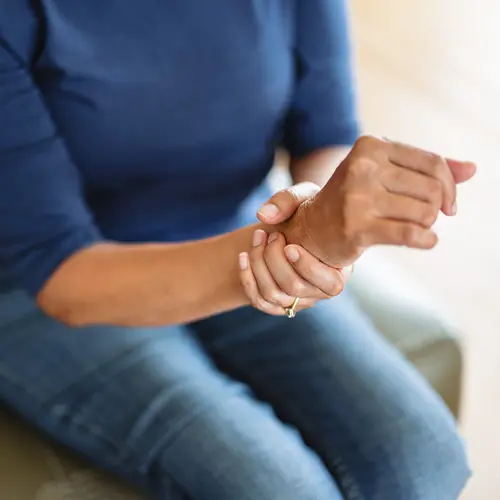As you get older, you have a higher risk of arthritis. The joint damage from this condition can cause swelling, pain, and physical changes in your feet and ankles.
Foot and Ankle Arthritis Types
Arthritis is a general term for a group of more than 100 diseases. It can involve inflammation and swelling in and around your joints and the nearby soft tissue.
With many kinds of arthritis, your joints wear down over time. You slowly lose the smooth "cushioning" cartilage inside them. As a result, your bones rub and wear against each other. Soft tissues in your joints also may begin to wear down. After some time, the joint might not work or move the way it should.
Several types of arthritis can cause pain in your feet and ankles, including:
- Osteoarthritis, or "wear-and-tear" arthritis, is the most common type. Doctors also call it degenerative joint disease or age-related arthritis. Osteoarthritis usually causes changes over many years. The foot and ankle joints where it’s most common are:
- The three joints involving your heel bone, your inner mid-foot bone, and your outer mid-foot bone
- The joint of your big toe and foot bone
- The joint where your ankle and shinbone meet
- Rheumatoid arthritis is one of the most serious forms. It’s an autoimmune disease in which your immune system attacks the joint. It usually happens in the same joint on both sides of your body.
- Gout happens when you have a buildup of uric acid from your diet. It’s most common in your big toe because it’s the farthest body part from your heart.
- Psoriatic arthritis can happen in one or more joints, including your ankles and the ends of your toes. It may also cause toe swelling called dactylitis.
- Post-traumatic arthritis happens after an injury, especially a dislocation or bone fracture. You might not notice problems for years.
Foot and Ankle Arthritis Symptoms
Symptoms of foot and ankle arthritis often include:
- Tenderness when you touch the joint
- Pain when you move it
- Trouble moving, walking, or putting weight on it
- Joint stiffness, warmth, or swelling
- More pain and swelling after you rest, such as sitting or sleeping
Foot and Ankle Arthritis Diagnosis
Your doctor will ask about your medical history and do tests that might include:
- A physical exam
- X-rays
- MRI or CT scans
Foot and Ankle Arthritis Treatment
Depending on your symptoms and what’s causing your arthritis, you might have one or more of these treatments:
- Steroid medications injected into your joints
- Anti-inflammatory drugs to help with swelling
- Pain relievers
- Pads or arch supports in your shoes
- Canes or braces for support
- Shoe inserts that support your ankle and foot (orthotics)
- Physical therapy
- Custom-fitted shoes
Surgery for foot and ankle arthritis
Some people need at least one kind of surgery to treat foot and ankle arthritis. Your doctor will suggest the treatment that’s best for you. Surgeries for arthritis include:
- Fusion surgery. This is also called arthrodesis. It involves fusing bones together with rods, pins, screws, or plates. After they heal, the bones remain joined.
- Joint replacement surgery. This is mostly used in severe cases. Your doctor may call it arthroplasty. They’ll take out damaged bone and cartilage and replace it with metal or plastic.
Home Remedies for Foot Arthritis Pain
When you have arthritis in your foot or ankle, one of the most important things is to wear comfortable shoes. Look for these details:
- Shoes shaped like your foot
- Shoes with good support (for example, no slip-ons)
- Rubber soles for more cushioning
- Flexibility
- Proper fit; ask a salesperson for help
Exercise can help keep your feet strong, flexible, and pain-free. Moves that can be good for your feet include:
- Achilles stretch. Face a wall with your palms flat against it. Step one foot forward and one foot back. Lean forward, keeping your heels on the floor. Feel the pull in the Achilles tendon and calf of your rear leg. Hold for 10 seconds. Repeat this exercise three times on each side.
- Big-toe stretch. Put a thick rubber band around your big toes. Use your muscles to pull them away from each other and toward your other toes. Hold this position for 5 seconds. Repeat 10 times.
- Toe pull. Put a rubber band around the toes of each foot, and spread your toes. Hold this position for 5 seconds, and repeat the exercise 10 times.
- Toe curl. Pick up marbles with your toes.
Other home remedies for arthritis are:
- Over-the-counter nonsteroidal anti-inflammatory drugs (NSAIDs) such as ibuprofen and naproxen. These can have side effects like stomach irritation, so check with your doctor before taking them.
- Creams with menthol or capsaicin, which may stop your nerves from sending pain signals
- Putting heat or cold on the area
- Acupuncture
- Glucosamine and chondroitin supplements
- Gentle exercises such as yoga and tai chi
- Massage
Lifestyle Changes for Foot Arthritis
A few changes to your daily life can help you feel better and may keep your arthritis from getting worse.
- If a certain activity triggers a flare-up of symptoms, try to keep it to a minimum.
- Instead of high-impact exercises like jogging, do low-impact ones like swimming or cycling.
- Keep a healthy weight so your joints aren’t under as much stress.

